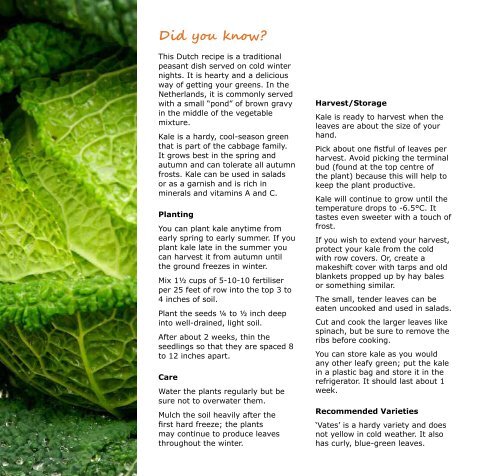Final recipes book
You also want an ePaper? Increase the reach of your titles
YUMPU automatically turns print PDFs into web optimized ePapers that Google loves.
Did you know?<br />
This Dutch recipe is a traditional<br />
peasant dish served on cold winter<br />
nights. It is hearty and a delicious<br />
way of getting your greens. In the<br />
Netherlands, it is commonly served<br />
with a small “pond” of brown gravy<br />
in the middle of the vegetable<br />
mixture.<br />
Kale is a hardy, cool-season green<br />
that is part of the cabbage family.<br />
It grows best in the spring and<br />
autumn and can tolerate all autumn<br />
frosts. Kale can be used in salads<br />
or as a garnish and is rich in<br />
minerals and vitamins A and C.<br />
Planting<br />
You can plant kale anytime from<br />
early spring to early summer. If you<br />
plant kale late in the summer you<br />
can harvest it from autumn until<br />
the ground freezes in winter.<br />
Mix 1½ cups of 5-10-10 fertiliser<br />
per 25 feet of row into the top 3 to<br />
4 inches of soil.<br />
Plant the seeds ¼ to ½ inch deep<br />
into well-drained, light soil.<br />
After about 2 weeks, thin the<br />
seedlings so that they are spaced 8<br />
to 12 inches apart.<br />
Care<br />
Water the plants regularly but be<br />
sure not to overwater them.<br />
Mulch the soil heavily after the<br />
first hard freeze; the plants<br />
may continue to produce leaves<br />
throughout the winter.<br />
Harvest/Storage<br />
Kale is ready to harvest when the<br />
leaves are about the size of your<br />
hand.<br />
Pick about one fistful of leaves per<br />
harvest. Avoid picking the terminal<br />
bud (found at the top centre of<br />
the plant) because this will help to<br />
keep the plant productive.<br />
Kale will continue to grow until the<br />
temperature drops to -6.5°C. It<br />
tastes even sweeter with a touch of<br />
frost.<br />
If you wish to extend your harvest,<br />
protect your kale from the cold<br />
with row covers. Or, create a<br />
makeshift cover with tarps and old<br />
blankets propped up by hay bales<br />
or something similar.<br />
The small, tender leaves can be<br />
eaten uncooked and used in salads.<br />
Cut and cook the larger leaves like<br />
spinach, but be sure to remove the<br />
ribs before cooking.<br />
You can store kale as you would<br />
any other leafy green; put the kale<br />
in a plastic bag and store it in the<br />
refrigerator. It should last about 1<br />
week.<br />
Recommended Varieties<br />
‘Vates’ is a hardy variety and does<br />
not yellow in cold weather. It also<br />
has curly, blue-green leaves.


